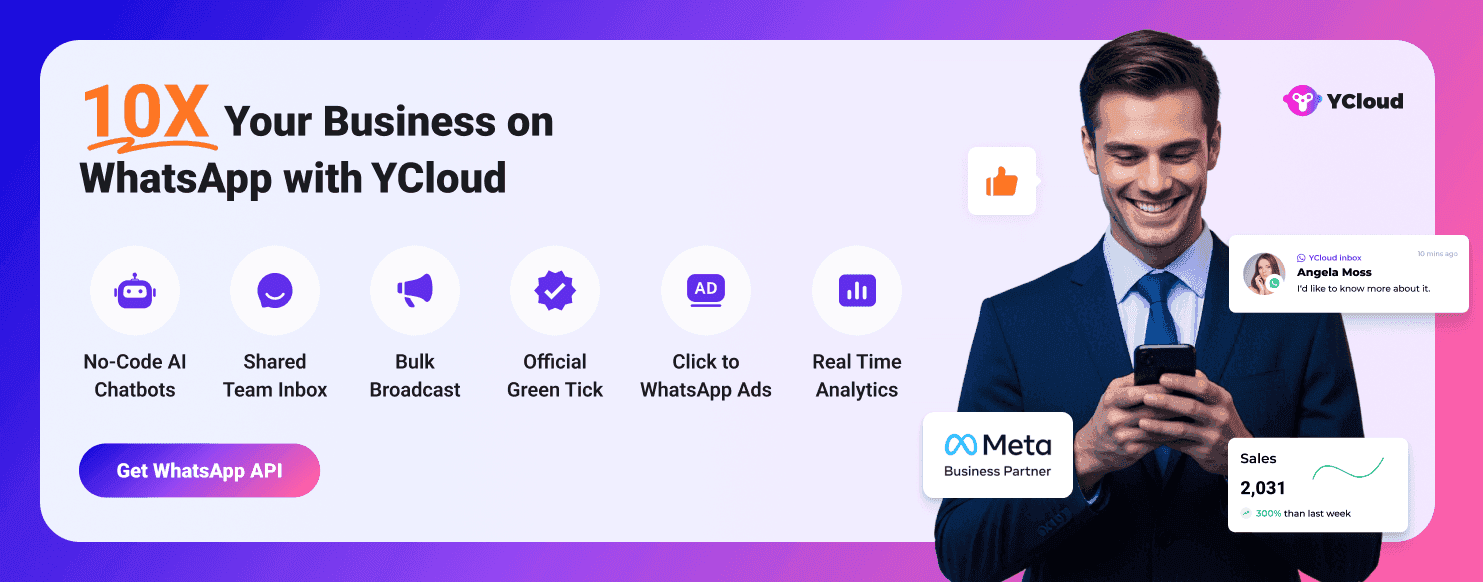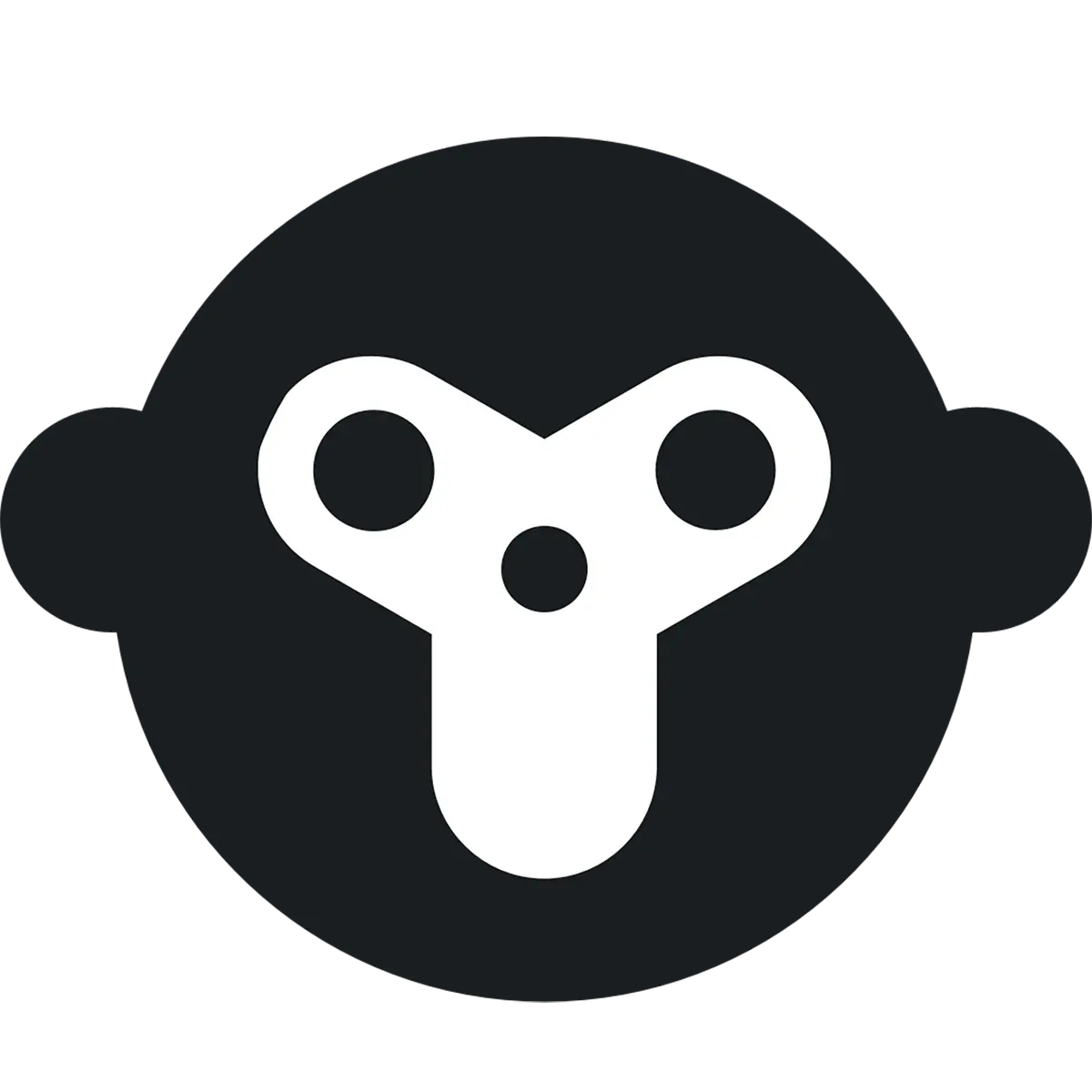The Definitive Guide to WhatsApp Marketing Strategies for 2026

Most brands today are battling the same frustration!
Emails go unread, ads get ignored, and organic reach has collapsed.
You invest in content, campaigns, and automation, but customers still slip through the cracks because every channel feels overcrowded, overused, and underperforming.
Meanwhile, your customers are doing something very different!
They’re spending most of their day on messaging apps, especially WhatsApp!
Talking, shopping, asking questions, and making decisions in real time. And this is exactly where modern marketing is quietly shifting.
And that’s where WhatsApp marketing steps in.
Not as another “nice-to-have” channel, but as a high-intent, high-attention space where businesses can actually start conversations, move leads faster, personalise at scale, and drive real revenue without fighting algorithms or ad fatigue.
Who is this guide for?
This guide is designed for marketing managers, business strategists, CRM teams, digital leaders, founders, CMOs, and customer experience managers at growth-oriented B2B and B2C brands who want to:
- New to WhatsApp marketing? Understand the basics, see real-world use cases, and learn exactly how to launch your first campaigns.
- Already using WhatsApp? Learn advanced strategies to unlock more revenue and improve campaign performance.
What you’ll learn
You’ll learn what is WhatsApp marketing? How does it work? What strategies actually drive revenue? How do leading brands use it at scale with industry-specific playbooks?
Best practices, mistakes to avoid, and how to scale all of it using the WhatsApp Business API.
If you’ve been looking for a definitive guide to understand how WhatsApp can fit into your growth engine, you’re exactly in the right place.
Next, let’s break down what is WhatsApp marketing and how it’s different from every other channel you use.
What Is WhatsApp Marketing?
WhatsApp marketing is the practice of using WhatsApp to connect with customers, share updates, run promotions, and drive revenue through fast, two-way conversations.
Small businesses typically use the WhatsApp Business App, while medium and large enterprises use the WhatsApp Business API through a trusted Tech Provider or WhatsApp Partner such as YCloud to manage automation, bulk messaging, segmentation, and integrations at scale.
Simply put:
WhatsApp marketing blends conversation + automation to help brands engage, convert, and support customers in the most frictionless way possible.
Next, let’s compare WhatsApp with other marketing channels to understand where it truly stands.
WhatsApp vs. Traditional Marketing Channels
Channel | Best For | Strengths | Considerations |
|---|---|---|---|
WhatsApp | Conversational marketing, customer engagement, loyalty programs, support, global audiences | - 3.5+ Billion Global Users - 98% Message open rate - 45-60% Click-through rate - Rich media (buttons, images, videos, catalogs) - Real-time two-way communication - Works well for personalised journeys & automation - Trusted app with billions of daily users | - Requires user opt-in - Templates need approval for outbound messages - Needs a provider/tech setup for scale (API) |
SMS | Urgent alerts, OTPs, reminders, flash sales | - Immediate delivery - Works on every mobile device (no internet required) - High visibility for critical updates - Supports MMS/RCS for richer experiences | - Not conversational - Limited media formats in some regions - Users in WhatsApp-dominant markets prefer messaging apps |
Email | Newsletters, long-form content, onboarding, transactional notifications | - Great for detailed communication - Highly scalable & cheap - Easy to segment and automate - Works well for documentation and long workflows | - Low open rates - Often lands in spam or promotions - Weak for real-time or high-intent engagement |
Next, let’s look at why WhatsApp should be part of every brand’s marketing strategy in 2026.
Why WhatsApp Should Be Part of Your 2026 Marketing Stack
WhatsApp has become one of the most effective channels for customer engagement, conversions, and retention. With billions of users relying on it daily for personal communication, brands now have a unique opportunity to show up in the same inbox, instantly, securely, and with far higher visibility than traditional channels.
Below are the core reasons why WhatsApp belongs in every modern marketing stack in 2026:
1. Your Customers Already Live on WhatsApp
WhatsApp is the world’s #1 messaging app, used by nearly 3.5+ billion monthly users across 180+ countries.
In regions like India, Brazil, Indonesia, LATAM, SEA, and parts of Europe, WhatsApp is the default communication channel, making it a natural fit for marketing, support, and commerce.
If your audience is mobile-first, global, or underserved by email, WhatsApp gives you instant access to where they already spend their time.
2. Unmatched Visibility and Engagement
WhatsApp offers some of the strongest performance metrics in marketing today:
- Up to 98% open rates
- 90–120 second average response time
- High click-through rates thanks to rich media & interactive elements
- Extremely low bounce/spam rates due to opt-in rules
For brands, this means your promotions, alerts, reminders, and updates are almost guaranteed to be seen.
3. Built for Real Conversations, Not One-Way Blasts
WhatsApp marketing isn’t “blast and pray.”
It’s conversational, interactive, and designed for two-way engagement.
With features like:
- Quick reply buttons
- Product catalog
- Rich images/videos
- Carousels
- List messages
- In-thread surveys
- Automated journeys
…businesses can turn static campaigns into real conversations that guide customers from discovery → decision → conversion in the same chat.
4. High Conversions and Proven Revenue Impact
Brands using WhatsApp see 45–60% conversion rates on key campaigns, far higher than SMS or email.
WhatsApp excels in:
- Abandoned cart recovery
- Product recommendations
- Back-in-stock alerts
- Upsell/cross-sell flows
- COD confirmation
- Subscription renewals
- Win-back and reactivation
In some markets, the revenue per recipient (RPR) averages €1.88, making WhatsApp one of the highest-performing revenue channels globally.
5. Strong Customer Trust, Privacy & Security
WhatsApp’s end-to-end encryption, strict opt-in rules, verified business profiles, and no-ads interface make customers more confident engaging with brands.
Since every message requires consent, customers know the content is relevant, not intrusive, leading to higher engagement and lower opt-outs.
6. Designed for the Entire Customer Lifecycle
WhatsApp supports full-funnel interactions through a single channel:
- Awareness → product education
- Consideration → catalog, FAQs, demos
- Purchase → checkout support, nudges
- Post-purchase → tracking, support, refunds
- Retention → offers, loyalty, updates
Few channels can offer CRM, marketing, support, and commerce, all in one thread.
7. Continuous Innovation from Meta
Meta is heavily investing in the WhatsApp Business Platform:
- More automation capabilities
- Better template formats
- Conversation-based journeys
- Payments & commerce experiences
- AI-powered interactions
- New ad formats linking into WhatsApp
This means the channel will only become stronger, more feature-rich, and more valuable for marketers.
8. Global Scalability at a Lower Cost
Compared to SMS and paid ads, WhatsApp is:
- More affordable for international reach
- More reliable for delivery
- More effective for engagement
- More scalable via the WhatsApp Business API
For brands managing multiple regions or large audiences, it delivers strong ROI without inflated channel costs.
9. Personalization at Scale
With behavioral tags, customer segmentation, and automated WhatsApp flows, brands can tailor:
- Offers
- Triggers
- Recommendations
- Reminders
- Journeys
…based on customer behavior and preferences.
This level of personalization directly boosts conversion and customer lifetime value.
10. Trusted for Enterprise, Accessible for SMBs
- SMBs → WhatsApp Business App (free, easy to use)
- Mid-market + enterprise → WhatsApp Business API via BSP such as YCloud
This flexibility makes WhatsApp usable for every type of business—from local stores to large global brands.
In Short
WhatsApp delivers high reach, high engagement, secure interactions, personalized journeys, and measurable revenue, all inside the world’s most trusted messaging app.
It’s one of the few marketing channels where customers actually enjoy hearing from brands.
Next, let’s look at how effective WhatsApp marketing really is and what results you can expect.
How Effective Is WhatsApp Marketing Really?
WhatsApp marketing consistently outperforms traditional channels when used in the right markets and with the right strategy. Because customers already rely on WhatsApp for daily communication, brands see significantly higher engagement and faster responses compared to email or SMS.
Here’s what makes WhatsApp highly effective:
1. High consumer adoption across major markets
WhatsApp dominates in the UK, France, Spain, Italy, India, Indonesia, Singapore, Malaysia, Australia, Mexico, Brazil, and many parts of the US. In these regions, it’s the preferred channel for brand communication.
2. Higher conversions through real-time conversations
Personalized, interactive messages lead to stronger intent and faster purchase decisions.
WhatsApp journeys often outperform email and SMS in both click-through and conversion rates.
3. Faster customer service resolution
Customers respond quickly on WhatsApp, reducing support wait times and improving satisfaction scores.
4. Improved loyalty and retention
Post-purchase follow-ups, replenishment reminders, alerts, and targeted offers keep customers coming back.
5. Stronger omnichannel performance
When paired with email, SMS, push notifications, and paid ads, WhatsApp helps brands reach customers on the channel they prefer, increasing total campaign impact.
In short, WhatsApp marketing is effective because it meets customers where they already are, active, responsive, and ready to engage.
Next, let’s break down how WhatsApp marketing actually works and what goes into running successful campaigns.
How Does WhatsApp Marketing Work?
WhatsApp marketing becomes powerful when you combine four things:
1. The right setup
2. A clear strategy
3. Compliant opt-ins
4. Consistent optimization
Below is a simple, practical breakdown of how brands actually run WhatsApp marketing at scale.
1. Set Up Your WhatsApp Business Platform (API)
Small teams can start with the WhatsApp Business App, but medium and large brands need the WhatsApp Business API to send broadcasts, automate journeys, and integrate with CRM systems.
Steps to get started with the WhatsApp Business Platform:
- Create or log into your Meta Business Account
- Go to Business Settings → WhatsApp Accounts
- Click Add → Create WhatsApp Account
- Submit business details, timezone, currency & optional payment info
- Add team members and assign permissions
- Connect your WhatsApp number
- Start creating templates and managing conversations
Once approved, you can manage message templates, analytics, and settings directly from Meta Business Manager or via your chosen WhatsApp Solution Partner (like YCloud).
2. Integrate WhatsApp With Your Existing Tech Stack
To run high-performing campaigns, brands integrate WhatsApp with:
- CRM platforms (HubSpot, Salesforce, Zoho, Klaviyo)
- Marketing automation tools
- Support helpdesks (Zendesk, Gorgias, Freshdesk)
- POS & ERP systems
- Chatbot platforms & AI assistants
Integration enables personalized triggers like:
- Abandoned cart reminders
- Price drop alerts
- Replenishment reminders
- Product recommendations
- Loyalty milestones
Real example: Tata CLiQ automated WhatsApp messages based on browsing activity and cart events, achieving 57% CTR and 10× ROI during Diwali/Black Friday.
3. Identify Your WhatsApp Campaign Goals & Audience
Before sending your first message, define what you're trying to achieve:
Common WhatsApp campaign goals
- Generate new leads
- Convert high-intent buyers
- Recover abandoned carts
- Educate & onboard new customers
- Offer real-time support
- Retain & reactivate dormant users
- Build loyalty & repeat purchase cycles
Map goals to funnel stages
- Awareness: Click-to-WhatsApp Ads, product launches
- Consideration: Catalog, FAQs, product finder flows
- Conversion: Discounts, reminders, back-in-stock alerts
- Retention: Reorder alerts, feedback requests, loyalty nudges
The clearer your goal → the clearer your campaign structure.
4. Create Entry Points That Lead People Into WhatsApp
Entry points are “doors” through which customers start a WhatsApp chat.
High-performing entry points
- Website chat widgets
- Exit-intent popups
- QR codes on packaging/storefronts
- Click-to-WhatsApp Ads (Facebook & Instagram)
- Social media posts & stories
- Thank-You page buttons after checkout
- Email signatures linking to WhatsApp
- Offline billboards, receipts, flyers
Why this matters:
People won’t message your brand unless you show them where and how.
Entry points boost opt-ins, traffic, and conversation starters instantly.
5. Design Your WhatsApp Campaign Message
Once a user enters the chat, the conversation has two phases:
1. The initial greeting (auto-response)
Example:
“Hi! Thanks for reaching out. Looking for something specific? I’m here to help 😊”
2. The follow-up flow
This can be:
- A live agent
- A structured WhatsApp chatbot
- A guided product finder
- A simple interactive menu
- A step-by-step question flow
During this conversation window, you can:
- Answer questions
- Recommend products
- Collect opt-ins
- Push customers to conversion
Once the window closes (24 hours or entry point–specific), you’ll need opt-in to message them again.
6. Collect Explicit Opt-Ins (Mandatory for Marketing Messages)
WhatsApp requires businesses to collect clear customer consent before sending outbound promotional messages.
Valid opt-in methods
- Website forms
- Popups with WhatsApp benefit offer
- Checkout tickbox
- QR code opt-ins
- CTWA ads
- Customer-infused “YES” reply
- In-store signage
Opt-in must clearly state:
- The brand name
- Type of messages they’ll receive
- How to opt out anytime
Once you have consent → you can start bulk & automated WhatsApp marketing.
7. Build Segment-Based Campaigns & Automations
WhatsApp works best when messages are personalized based on behavior.
Segment examples
- New leads
- Abandoned carts
- Repeat buyers
- High-value customers
- Dormant users
- COD verification
- Viewed specific product categories
Common WhatsApp automations:
- Welcome flows
- Abandoned cart reminders
- Order & shipping updates
- Reorder/replenishment nudges
- Feedback & review requests
- Loyalty program updates
- Back-in-stock alerts
These feel personal and convert extremely well.
8. Use Rich Media & Interactive Elements
WhatsApp supports interactive formats that boost click-through and conversions.
Use:
- Images, videos, GIFs
- Carousel messages
- Product catalogs
- CTA buttons
- Quick-reply buttons
- List messages
- PDFs, invoices, receipts
- Location sharing
- In-thread links
Interactive messages dramatically increase engagement vs plain text.
9. Send Personalized WhatsApp Broadcasts
Broadcasts allow you to reach 1,000s of opted-in users at once with personalized content.
Best use-cases:
- Flash sales
- Product drops
- Back-in-stock
- Price drops
- Festive campaigns
- Referral pushes
- Seasonal offers
- Appointment reminders
Done right, broadcasts deliver:
- Up to 98% open rate
- 45–60% CTR
- Massive revenue bursts during peak season
10. Measure, Analyze & Constantly Optimize
Monitor performance and identify what’s driving revenue.
Track:
- Delivery rate
- Read rate
- Click-throughs
- Conversion rate
- Opt-outs
- Response time
- Revenue attribution
- Block rate
Improve continuously by testing:
- Message copy
- Timing
- Media format
- CTA button text
- Template variations
- Segments
- Entry points
Optimization is what turns WhatsApp from a channel into a revenue engine.
In a nutshell...
It follows a simple formula:
Setup → Integrate → Collect opt-ins → Segment → Automate → Broadcast → Measure → Optimize
When executed correctly, WhatsApp becomes one of the highest-performing channels for engagement, conversions, and customer retention.
Next, let’s discover how to get started with WhatsApp marketing.
How to Get Started With WhatsApp Marketing?
⚠️ Quick note:
Small businesses can start with the free WhatsApp Business App.
This section focuses on brands that want to use the WhatsApp Business API Platform for bulk WhatsApp marketing, automation, and integrations.
1. Choose the Right WhatsApp Setup
- WhatsApp Business App – Best for very small teams, manual replies, and basic use.
- WhatsApp Business API – Best for growing and enterprise brands that need:
- Bulk WhatsApp marketing campaigns
- Automation and chatbots
- Multi-agent inbox
- Deep CRM / eCommerce integrations
2. Select an Official WhatsApp Solution / Tech Partner
- WhatsApp Business Solution Provider such as YCloud
- Tech Partner / Messaging Platform
- Set up your WhatsApp Business Platform account
- Connect your Meta BusinessAccount
- Get your business phone number and display name approved
- Manage templates, compliance, and conversation categories
- Give your team access to a shared inbox, automation tools, and reporting
3. Integrate WhatsApp With Your Existing Stack
- CRM (HubSpot, Salesforce, Zoho, etc.)
- eCommerce (Shopify, WooCommerce, custom store)
- Support platforms (Zendesk, Gorgias, Freshdesk, etc.)
- Payment / billing tools
- Analytics / CDP
- Trigger WhatsApp flows from events (e.g., abandoned cart, signup, COD order)
- Use customer data for segmented and personalized campaigns
- See WhatsApp conversations alongside other channels
4. Build Your WhatsApp Audience (With Proper Opt-Ins)
Ways to collect WhatsApp opt-ins:
Website popups or banners
“Get order updates & VIP offers on WhatsApp”
Checkout page checkboxes
“Send me shipping updates and offers on WhatsApp”
Click-to-WhatsApp Ads (Facebook & Instagram)
Ads that open a WhatsApp chat instead of a landing page
QR codes on:
In-store posters, receipts, packaging, flyers
Thank-you pages and email flows
Invite new customers to continue the journey on WhatsApp
Social media bios / stories
“Tap to chat with us on WhatsApp”
- Who you are
- That they’re signing up for messages on WhatsApp
- What kind of messages they’ll receive (offers, updates, alerts, etc.)
5. Set Up Your WhatsApp Business Profile & Basics
- Add business name, logo, website, email, address, hours
- Write a short, clear business description
- Set up:
- Greeting message for new chats
- Away message for off-hours
- Quick replies for FAQs (pricing, delivery, refunds, etc.)
6. Create Templates & Launch Your First Campaigns
- Marketing – offers, new arrivals, campaigns
- Utility – order confirmations, shipping updates, appointment reminders
- Alerts – back-in-stock, price drops, payment reminders
- Short, clear, and action-oriented
- Personalized (name, product, order status)
- Compliant (no spammy or misleading claims)
- Send broadcast campaigns to segmented lists
- Trigger automated flows based on behavior
- Run onboarding and welcome journeys for new subscribers
7. Automate, Scale & Keep Improving
- Chatbots & flows for FAQs, lead qualification, and simple purchases
- Drip sequences for onboarding, education, and nurturing
- Abandoned cart flows and win-back campaigns
- Broadcasts for launches, festive campaigns, and loyalty offers
- Delivery & read rates
- CTR & replies
- Conversions & revenue
- Opt-out and block rates
- Timing and frequency
- Segments
- Copy, creatives & CTAs
- Which WhatsApp marketing strategies actually move numbers
Proven WhatsApp Marketing Strategies for 2026
1. Click-to-WhatsApp Ads (CTWA)
- Reduces drop-off by removing landing pages
- Captures verified names & phone numbers instantly
- Ideal for lead generation, ecommerce discovery, demos, and service queries
- Highest ROI among Meta ad formats for direct engagement
2. SmartAds (AI-Generated WhatsApp Ads)
Perfect for brands that want speed + conversions without hiring a design team.
- Faster ad deployment
- Algorithm-optimized creatives
- Generates higher-quality leads
- Perfect for D2C, beauty, fashion, electronics, and FMCG
3. Automated Notifications & Reminders
- Order confirmation
- Shipping updates
- Delivery reminders
- Cart abandonment alerts
- Payment follow-ups
- Appointment reminders
4. Broadcast Marketing Campaigns
- 85–98% open rate
- Immediate visibility
- Works exceptionally well with segmented lists
5. WhatsApp Flows (Interactive Mini-Apps)
- Lead forms
- Product recommenders
- Appointment booking
- Feedback surveys
- Event registrations
- Order journeys
6. WhatsApp Catalogs
- Showcase up to 500 products
- Reduces website dependency
- Faster product discovery
- Works seamlessly with cart + payment journeys
7. WhatsApp Pay
- Instant UPI, card, or net-banking payments
- No redirects
- Secure and frictionless
- Useful for COD conversions, renewals, reorders, and subscriptions
8. Personalized Marketing Messages
- Customer name
- Location
- Past orders
- Browsing history
- Wishlisted items
- Loyalty points
9. CTA & Quick Reply Buttons
- Buy Now
- View More
- Track Order
- Book Slot
- Claim Offer
- See Catalog
10. WhatsApp Automation (24/7 Support + Lead Nurturing)
- Answer FAQs
- Qualify leads
- Capture customer data
- Route complex queries to agents
- Recommend products
- Send updates
11. WhatsApp Button on Your Website
- Homepage
- Product pages
- Checkout page
- Help section
- Blogs
12. Share WhatsApp Links Across All Channels
- Instagram bio
- Facebook page
- YouTube description
- Email signatures
- SMS campaigns
- Google Business Profile
- Offline: brochures, packaging, store displays
13. WhatsApp Loyalty Programs
- Points balance updates
- Tier upgrades
- Cashback notifications
- Referral bonuses
- VIP early access
14. Challenges & Quizzes
- Festival quizzes
- Spin-the-wheel
- “Find your product match” flows
- Trivia contests
- Giveaway challenges
15. Carousel Message Templates
- New arrivals
- Top sellers
- Weekly deals
- Product bundles
- Seasonal campaigns (Diwali, BFCM, Valentine’s Day)
16. WhatsApp Retargeting Campaigns
- Viewed your catalog
- Didn’t complete purchase
- Clicked but didn’t reply
- Replied but didn’t buy
- Didn’t open the previous broadcast
- Lapsed customers
- High-intent users (via RFM segmentation)
Up next, let's explore the key WhatsApp marketing features to use.
Key WhatsApp Marketing Features to Use
1. Click-to-WhatsApp Ads (CTWA)
How CTWA ads help:
- Instantly start WhatsApp conversations
- Capture verified names + phone numbers
- Track full funnel (impressions → chats → conversions → ROAS)
- Reduce friction and boost lead generation
Best for:
- Lead generation
- Product discovery
- Re-engagement
- High-intent retargeting
Ideal message type: WhatsApp Flows
2. WhatsApp Flows (End-to-End Journeys Inside WhatsApp)
Think of them as mini-apps inside chat.
Use cases:
- Appointment scheduling
- Product finders
- Lead forms
- Event registrations
- Personalized recommendations
- In-thread surveys
3. WhatsApp Chatbots (Marketing + Support)
Why chatbots matter:
- Qualify leads automatically
- Provide instant replies 24/7
- Reduce agent workload
- Capture first-party data
- Personalize recommendations
- Drive users to product catalogs, Flows, and CTAs
Ideal message type: Chatbot flows
4. Product Catalogs (In-Chat Shopping Experience)
Capabilities:
- Add up to 30 items (or more via API)
- Show photos, descriptions, pricing
- Let customers add items to cart
- Enable purchases within WhatsApp or redirect to website checkout
Use case examples:
- Cross-sell relevant products
- Upsell based on browsing history
- Promote category-specific items
Ideal message type: Product Catalogs
5. Carousel Messages (10 Scrollable Cards)
Brands can send up to 10 scrollable cards, each with images, descriptions, and buttons.
Great for:
- New arrivals
- Festive offers
- Flash sales
- Abandoned cart reactivation
- Travel package highlights
- Bundle offers
6. Event-Triggered Notifications
Trigger-based notifications include:
- Back-in-stock alerts
- Price drops
- Subscription renewals
- Contract expiry reminders
- Loyalty point reminders
- Refill reminders
Ideal message type:
7. Limited-Time Offer Messages (Countdown Timers)
What you can do:
- Display offer expiry timers
- Show countdown visuals
- Automatically deactivate coupons after expiration
- Create urgency for flash sales
Best for:
8. The Marketing Messages API (Advanced Automation & Targeting)
What it improves:
- Delivery rates
- Read rates
- Frequency optimization
- Smart targeting
- Automatically choosing best time to send
Ideal message type:
9. WhatsApp Payments (In-Chat Checkout)
Benefits:
- Zero redirection drop-offs
- Faster checkout
- Seamless buying journey
- Perfect for COD-to-prepaid conversion
Ideal message type: Payment request + catalog
10. Automated Customer Engagement
What can be automated:
- Welcome messages
- Onboarding sequences
- Lead nurturing
- Abandoned cart reminders
- Order updates
- Post-purchase flows
- Review & feedback collection
11. Timed Messages (Scheduled Promotional Alerts)
- Launch announcements
- Contract renewal reminders
- Sale start alerts
- Subscription expiry notices
12. In-Chat Checkout (End-to-End WhatsApp Commerce)
All in one thread.
Up next, let's discover the types of WhatsApp marketing messages you should send.
Types of WhatsApp Marketing Messages You Should Send
1. Acquisition & Initial Outreach
What you can send:
- First-purchase discounts
- Welcome offers for new subscribers
- New product announcements
- Seasonal & holiday campaigns
- Launch teasers and early-access offers
- Lead-generation follow-ups (via CTWA, QR codes, signup forms)
Goal:
2. Conversion Messages
What you can send:
- Abandoned cart reminders
- Back-in-stock alerts
- Price-drop alerts
- Low-stock urgency messages
- Browse abandonment follow-ups
- Product comparison or FAQs to help decision-making
Goal:
3. Re-Engagement & Retention Messages
What you can send:
- Personalized product recommendations (based on purchase history & behavior)
- Exclusive loyalty discounts
- Upsell & cross-sell suggestions
- Refill or re-order reminders
- Win-back campaigns for dormant customers
- Subscription renewal reminders
- Feedback & review requests
Goal:
Why Personalization Matters
✅ Higher engagement
✅ Stronger conversions
✅ +54% average increase in customer spending
- Personalized discounts
- Tailored abandoned cart reminders
- Intelligent product suggestions
- Dynamic campaigns based on user actions
Up next, let's see what are the key WhatsApp marketing metrics to track in 2026.
Most Important WhatsApp Marketing Metrics to Track in 2026
1. Delivery Rate
2. Open Rate
3. Response Rate
4. Click-Through Rate (CTR)
5. Engagement Rate
6. Conversion Rate
7. Opt-Out Rate
8. Average Response Time
9. Cost per Conversion
10. Customer Satisfaction Score (CSAT)
11. Net Promoter Score (NPS)
How These Metrics Strengthen Your WhatsApp Strategy
- Improve message relevance
- Optimize timing and frequency
- Reduce opt-outs
- Boost conversions
- Identify winning templates and flows
- Maximize ROI
The next section outlines best practices for effective WhatsApp marketing.
Best Practices for Doing WhatsApp Marketing Right
1. Always Collect Clear Opt-Ins
This protects your brand reputation and keeps your quality rating high.
- Click-to-WhatsApp ads (CTWA)
- Website pop-ups or chat widgets
- QR codes on packaging, in-store, or OOH
- WhatsApp buttons in emails or landing pages
2. Segment and Personalize Your Messages
- Use names, past purchases, browsing history
- Send tailored product recommendations
- Trigger automated flows based on customer actions
- Segment users into groups (new leads, high spenders, inactive users, etc.)
3. Deliver Real Value in Every Message
- Exclusive offers or early access
- Useful tips, updates, or how-tos
- Clear benefits tied to user needs
- Personalized deals, not generic blasts
4. Tap Into Rich Interactive Features
- Carousels for product highlights
- Catalogs for easy in-app browsing
- Quick reply buttons to reduce typing friction
- Call-to-action buttons for faster conversions
- Flows for end-to-end in-app journeys
- Rich media (images, GIFs, PDFs, videos) to simplify decisions
5. Master Timing & Frequency
- Avoid late-night or early-morning sends
- Test optimal send times via analytics
- Limit promotional sends to 1–2 per week
- Prioritize utility messages (order updates, reminders)
6. Respond Fast (Automation Helps)
- Chatbots for FAQs
- Automated follow-ups
- Quick replies for common queries
- Seamless handover to live agents
7. Build Entry Points Everywhere
- Product pages
- Social media bios
- Email signatures
- Landing pages
- Offline materials (QR codes on packaging, receipts, kiosks)
8. Track the Right Metrics
- Delivery Rate
- Open Rate
- CTR
- Response Rate
- Conversion Rate
- Opt-Out Rate
- Average Response Time
- CSAT & NPS
9. Respect Meta’s User-Level Message Limits
- Send fewer, higher-quality campaigns
- Prioritize personalization
- Space out marketing pushes
- Focus on relevance over volume
10. Maintain a Human, Conversational Tone
- Short, natural sentences
- Clear and friendly tone
- Two-way interaction
- Ask questions
- Encourage replies
- Provide helpful next steps
Quick Summary: The Golden Rules
- Get opt-ins
- Personalize deeply
- Provide value
- Use rich message formats
- Don’t spam
- Respond instantly
- Track everything
- Keep it human
Up next, let's explore the common WhatsApp marketing mistakes to avoid.
Common WhatsApp Marketing Mistakes to Avoid
1. Using WhatsApp for Hard Selling
- Prioritising value before promotion
- Sharing helpful content (tips, guides, reminders) that naturally leads into an offer
- Balancing promotional messages with interactive and educational ones
Value first → sales later.
2. Ignoring WhatsApp’s Messaging Rules
- Message users without explicit opt-in
- Buy contact lists
- Hide opt-out options
- Send bulk promotional blasts to cold audiences
- Collect documented opt-ins
- Give users an easy way to unsubscribe
- Follow WhatsApp’s Business and Commerce Policies
3. Overlooking Mobile-First Formatting
- Keeping messages short and scannable
- Using bullet points, line breaks, and clear CTAs
- Ensuring URLs, buttons, or quick replies are easily tappable
- Leading with the main benefit in the first two lines
4. Sending Too Many Messages
- Limit marketing sends to 2–3 per week
- Use analytics to understand ideal send times
- Let utility updates (delivery, order status, OTPs) be the exception
- Focus on relevance, not volume
Every message should feel intentional, not intrusive.
5. Neglecting a Consistent Brand Voice
- Writing like a real human from your brand
- Keeping tone consistent across messages
- Using conversational language instead of corporate jargon
- Adding a touch of personality where appropriate
In the next section, we’ll explore Industry-Specific WhatsApp Marketing Strategies and break down exactly how retail, B2B, real estate, fitness, education, food, travel, BFSI, and SaaS brands can tailor WhatsApp to their unique customer journeys.
Each industry has its own triggers, customer behaviors, sales cycle, and engagement style and your WhatsApp approach should reflect that.
Let’s begin with the first industry and break down practical, ROI-focused strategies for retail brands.
WhatsApp Marketing Strategies for Retail Stores
1. Send Product Restock Alerts
Example:“Hey Alex! 👟 Your favorite sneakers are back in stock. Grab them before they’re gone: [link]”
2. Offer Exclusive VIP Deals
Example:“VIP Exclusive 🎉 Get 48-hour early access to our End-of-Season Sale! Shop first 👉 [catalog link]”
3. Showcase New Collections with Carousel Messages
- Fashion: Highlight new-season bestsellers
- Electronics: Compare phones, earbuds, laptops, or appliances
- Beauty: Showcase shade variants or product combos
4. Drive Footfall with Flash Sale Alerts
Example:“FLASH SALE! 2 hours only ⚡ Get 20% off all accessories. Visit us before 5 PM!”
5. Launch a WhatsApp Loyalty Program
Offer points, perks, birthday rewards, or exclusive coupons directly via WhatsApp.
6. Create Personalized Shopping Experiences
✔ Style
✔ Budget
✔ Occasion
Example:“Hi Mia! Based on your recent purchase, here are a few new-season looks you’ll love 😍 [carousel]”Personalization = higher conversions.
7. Promote Store Events & Community Campaigns
- Add WhatsApp links to your Google Business Profile
- Add QR codes to store posters, shopping bags, and receipts
- Place a WhatsApp button on product pages to convert browsers into shoppers
Additional WhatsApp Marketing Ideas for Retail
✔ Flash sales & limited-time offers: Trigger instant FOMO during peak seasons.
✔ Loyalty updates: Share points, perks, and exclusive deals directly in WhatsApp.
✔ Abandoned cart reminders: Send gentle nudges to recover lost sales.
✔ Order & delivery updates: Build trust with real-time tracking.
✔ Seasonal promotions: Christmas, Diwali, Summer Sale, Black Friday, and more.
✔ Referral programs: Grow organically with “Share & Earn” campaigns on WhatsApp.
WhatsApp Marketing Strategies for B2B
1. Use WhatsApp for Lead Qualification & Instant Follow-Ups
✔ Capture business details
✔ Route hot leads to the right sales rep
2. Send Personalized Product Demos & Sales Collateral
Example:“Hi Sarah! Sharing the 2-minute walkthrough + case study you requested. Let me know if you’d like a live demo 👇”
3. Automate Meeting Reminders & Follow-Ups
✔ “Reschedule”
✔ “Add to calendar”
4. Share Tailored Quotes & Proposals
✔ “Request changes”
✔ “Talk to sales”
5. Use Broadcasts for New Feature Updates
✔ API updates
✔ Maintenance alerts
✔ New use cases
✔ Training materials
6. Build WhatsApp-Based Nurturing Sequences
- Cold lead → Problem awareness → Case study → Demo booking
- Trial user → Feature education → Activation → Paid upgrade
- Client onboarding → Training → Adoption → Upsell
7. Enable Multi-Agent Shared Inbox for Sales Teams
✔ Channel partners
✔ Customer success teams
✔ After-sales support
8. Announce Webinars, Workshops & Events
- Event invites
- Add-to-calendar buttons
- Reminders (1 day / 1 hour before)
- Follow-up resources
9. Offer Priority Support to Enterprise Clients
✔ Onboarding checklists
✔ Product SOPs
✔ Critical alerts
10. Send Re-Engagement Messages for Dormant Leads
- “Thought you’d like our new feature release!”
- “Here’s a case study from your industry.”
- “Can I help you complete your evaluation?”
Other High-Impact WhatsApp Ideas for B2B Brands
✔ Onboarding flows for new clients
✔ Personalized product recommendations
✔ Quote approvals & contract revisions
✔ Funnel-based drip sequences
✔ Renewal reminders & subscription nudges
✔ CRM-integrated client segmentation
WhatsApp Marketing Strategies for E-commerce Businesses
1. Recover Abandoned Carts Automatically
Example:“Hey Sam 👋 you left something behind! Complete your checkout now & get an extra 5% off: [link]”
2. Announce Product Launches with Exclusive Access
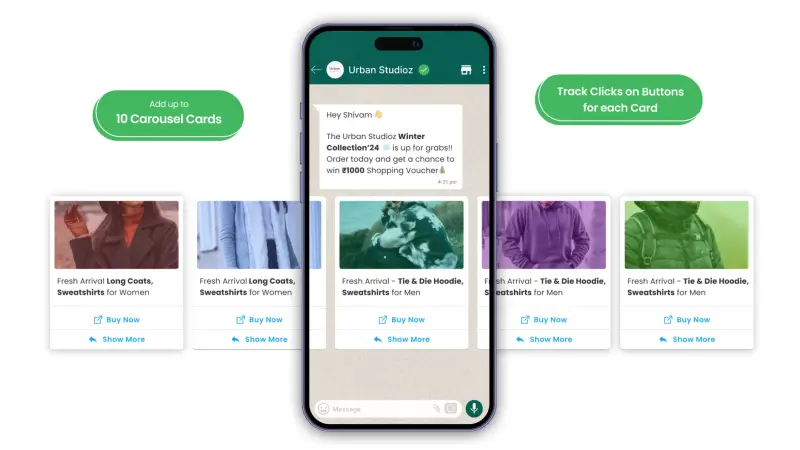
✔ Sneak-peek videos
✔ Limited pre-orders
✔ VIP-only collections
- New fashion drops
- Seasonal collections
- Gadget launches
- Festive exclusives
3. Send Personalized Product Recommendations
✔ Previous purchases
✔ Wishlist items
✔ Category interest
Example:“Hi Mia! Based on your last order, you might love these new arrivals 😍 [carousel]”
4. Automate Sales & Support with WhatsApp Chatbots
✔ Check product availability
✔ Recommend items
✔ Track orders
✔ Process returns
✔ Complete purchases inside chat
5. Boost Conversions with Flash Sale Alerts
🔥 “Last 100 units left!”
🔥 “Early access ends tonight!”
- Viewed the product
- Added to cart
- Clicked similar promotions
6. Extra High-Impact Ecommerce Strategies
WhatsApp Marketing Strategies for Real Estate Businesses
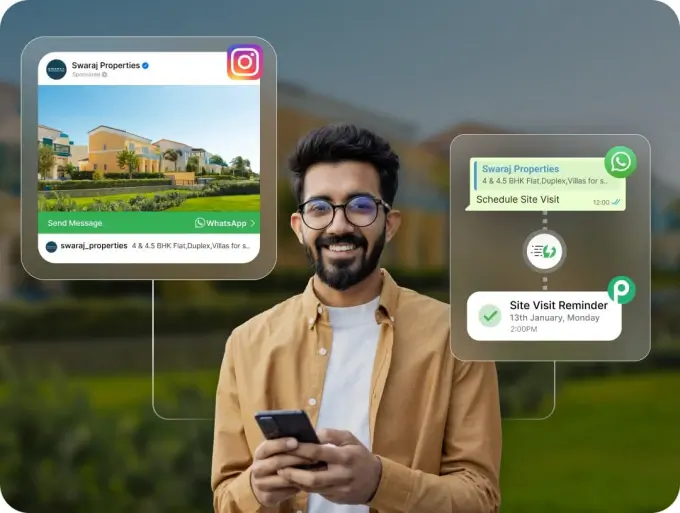
1. Qualify Leads Instantly with a WhatsApp Chatbot
- Preferred location
- Budget range
- Property type
- Furnishing/amenities preference
2. Automate Property Tour & Site Visit Scheduling
✔ Send confirmations & reminders
✔ Reduce no-shows
✔ Sync with CRM or Google Calendar
Send reminders like:“Hi Arjun! Your site visit at Prestige Lakeview is confirmed for tomorrow at 11 AM. Reply 1 to reschedule.”
3. Share Property Catalogs & Virtual Tours
- HD images
- Brochures & floor plans
- Walkthrough videos
- Pricing sheets
Use catalogs for quick browsing without needing a website.
4. Retarget Warm Leads Who Showed Interest
- Users who viewed a property
- Clicked a virtual tour
- Asked about pricing
- Engaged but didn’t convert
A simple follow-up message can revive dead leads:“Hi Sneha! Still exploring 3BHK options in HSR? We have a new unit available within your budget. Want details?”
5. Collect Testimonials & Build Trust
📝 Share My Experience
- Future WhatsApp campaigns
- Site-visit follow-ups
- Property announcements
- Landing pages
6. Bonus Strategies for Real Estate
✔ Add a WhatsApp Chat Button on listings, blogs, and homepages
✔ Share WhatsApp links across property portals (Magicbricks, 99acres, Housing)
✔ Use carousel messages to showcase multiple units, offers, or configurations
WhatsApp Marketing Strategies for Healthcare Businesses
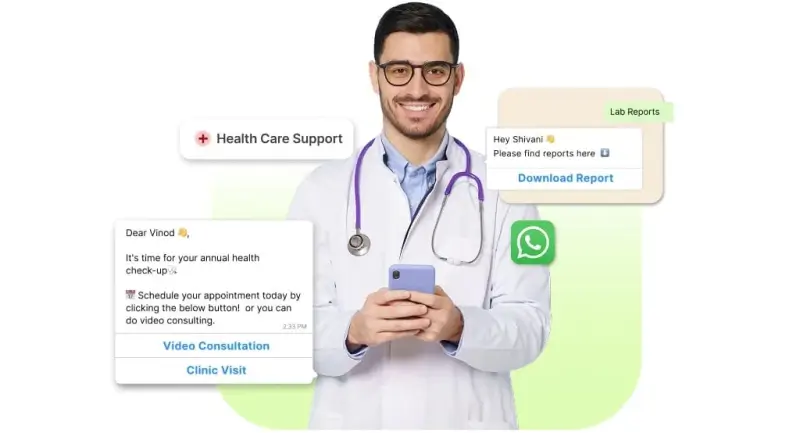
1. Automate Doctor’s Appointments & Reminders
- Booking confirmations
- Pre-visit reminders
- Follow-up notifications
- Test/vaccination reminders
2. Share Medical Reports & Important Documents
- Test results
- X-ray/scan reports
- Prescription copies
- Discharge summaries
3. Promote Health & Wellness Tips
- Daily health tips
- Seasonal illness alerts
- Diet & fitness advice
- Preventive care recommendations
4. Offer Virtual Consultations & Telehealth Support
- Initial symptom checks
- Follow-up reviews
- Mental health support
- Chronic care monitoring
5. Enable Smooth Chat-to-Human Handover
This ensures complex or sensitive cases get personalized attention—critical for building trust and patient satisfaction.
6. Bonus Strategies for Healthcare Providers
✔ Add a WhatsApp Chat Button on your website for instant inquiries or appointment bookings.
✔ Display a WhatsApp QR Code at your clinic for walk-in patients to connect instantly.
WhatsApp Marketing Strategies for Fitness & Wellness Businesses
1. Send Class Reminders & Schedule Updates
- Group classes
- Personal training sessions
- Virtual workshops
- Yoga/meditation classes
Example:"Hi Amanda! Your HIIT class starts in 2 hours Don’t forget your water bottle!"
2. Progress Tracking & Motivational Nudges
- Weekly progress check-ins
- Weight / measurement updates
- Habit reminders
- Motivational notes
Example:"Hey Ana! You’re just 2 sessions away from hitting your monthly goal. Book your next class now!"
3. Promote Fitness Challenges & Wellness Programs
- 30-day transformation challenges
- Diet + workout packages
- Home workout programs
- Subscription-based coaching
4. Broadcast Health Tips & Diet Plans
- Healthy recipes
- Diet charts
- Mindfulness tips
- Workout-of-the-day (WOD) routines
5. Send Personalized Recommendations
- Supplements
- Fitness gear
- Meal plans
- Premium coaching sessions
Example:"Based on your goal to build lean muscle, here are some products you might love 💪"
6. Collect Feedback & Testimonials
- ⭐ Session rating
- 👍🏻 / 👎🏻 Service review
- “Would you recommend us?”
7. Sell Directly on WhatsApp
- List training plans in WhatsApp Catalogs
- Sell fitness products
- Offer membership renewals
- Accept payments via WhatsApp Pay
WhatsApp Marketing Strategies for Education Businesses
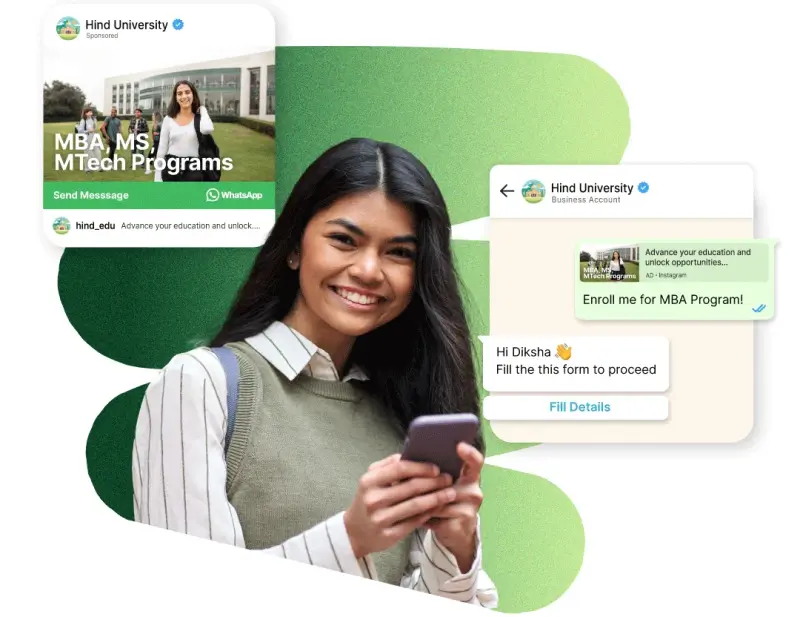
1. Promote Courses & Programs with Click-to-WhatsApp Ads
- Explore course details
- Ask questions
- Receive brochures
- Share contact information for follow-up
2. Qualify & Nurture Leads with AI-Powered Chatbots
3. Send Fee Reminders & Academic Notifications
- Fee due dates
- Application deadlines
- Exam schedules
- Class timings or changes
4. Re-Engage Application Drop-Offs
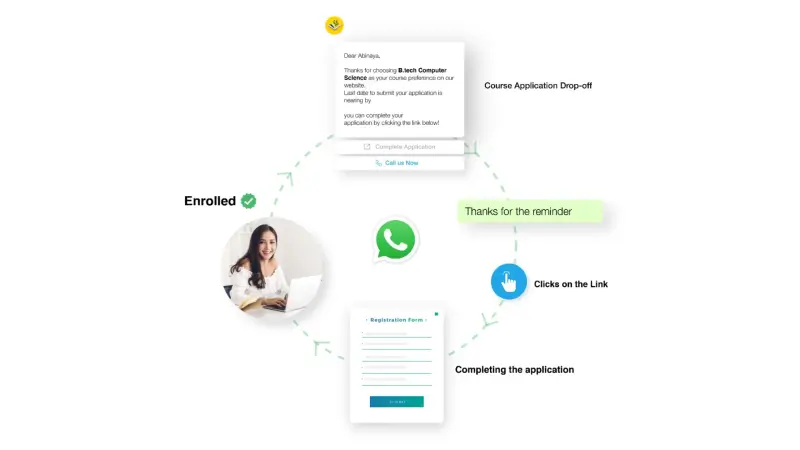
5. Enable Seamless Parent-Teacher Communication
- “Yes, I will attend”
- “Need more details”
- “Not attending”
Bonus Strategies for Educators
- Share brochures, course lists, or fee structures via WhatsApp Catalogs.
- Add a WhatsApp button to your website’s admission pages to boost inquiries.
- Use retargeting campaigns to reconnect with leads who dropped off mid-application.
WhatsApp Marketing Ideas for BFSI (Banking, Financial Services & Insurance)
1. Send Loan & Mortgage Application Updates
- Application submission confirmation
- Document verification status
- Approval or rejection updates
- Disbursal notifications
2. Deliver Account Balance & Transaction Alerts
- Real-time fraud prevention
- Faster customer awareness
- Improved digital engagement
3. Share Credit Card Usage & Reward Updates
- Monthly card usage summaries
- Reward points updates
- New cashback or offer alerts
- Credit limit changes
4. Send Loan Pre-Approval Notifications
- Personal loans
- Credit card upgrades
- Buy-now-pay-later approvals
- Pre-approved top-ups
Bonus Ideas for BFSI
- Use WhatsApp chatbots for KYC guidance, EMI calculations, policy selection, and insurance claim support.
- Enable WhatsApp-based appointment booking for branch visits or relationship manager calls.
- Share personalized financial product recommendations using customer transaction history or credit profile.
- Add WhatsApp chat to your website/app for instant queries during loan applications or insurance plan comparison.
WhatsApp Marketing Ideas for Travel & Hospitality Businesses
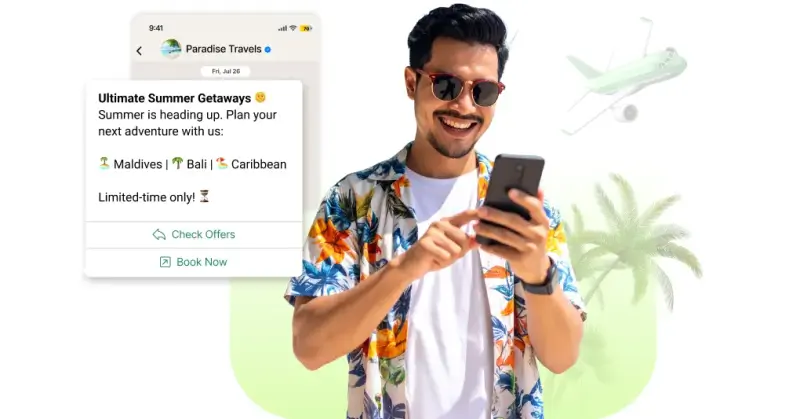
1. Deliver Exclusive Travel Deals & Discounts
- Flash sales on flights, trains, buses, and hotels
- Early-bird discounts for tours
- Festival season promotional packages
2. Share Booking Confirmations & Itinerary Updates
- Ticket confirmation
- Hotel booking details
- Check-in timings
- Airport pickup instructions
- Daily itinerary schedules
3. Promote Last-Minute Travel Offers
- Hotel rooms
- Flight seats
- Bus/Train seats
- Tour slots
4. Provide Visa & Documentation Assistance
- Visa checklist guidance
- Document reminders
- Status updates
- Pre-departure requirements
5. Offer Real-Time Support with Chatbots
- Check-in/out details
- Airport transfer requests
- Local recommendations
- Rescheduling queries
- Add-on purchases (tours, meals, experiences)
6. Upsell Rooms, Tours & On-Site Experiences
- Room upgrades
- Spa sessions
- Adventure tours
- Dinner reservations
- Airport lounge access
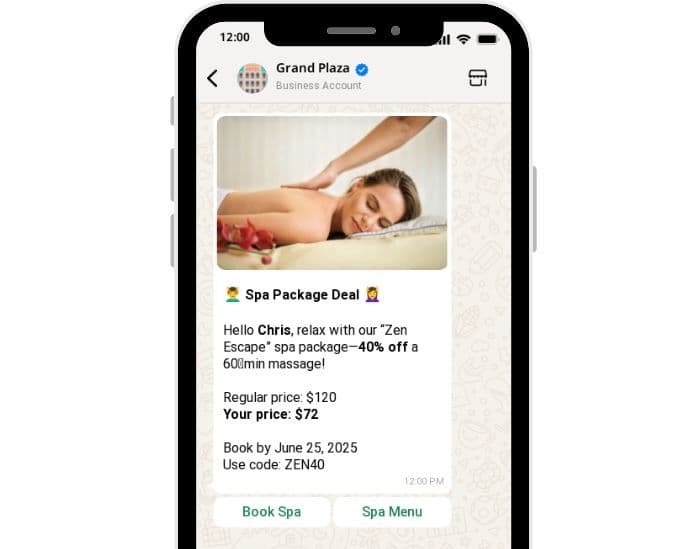
7. Personalize Pre-Arrival Communication
- Weather updates
- Packing tips
- Local guides
- Concierge contact details
- Pre-arrival offers
8. Run In-Destination Engagement Campaigns
- “Live music tonight 🎵”
- “Happy Hour 5–7 PM 🍹”
- “Last-minute spa appointments available 💆♀️”
- “Sunset cruise boarding in 1 hour ⛵️”
Bonus Travel Strategies
- Add a WhatsApp chat button to your travel or hotel website for instant support.
- Use QR-based WhatsApp links on brochures, airport kiosks, and in-room materials.
- Use WhatsApp Flows for automated itinerary planning and booking journeys.
WhatsApp Marketing Ideas for Food & Restaurant Businesses
1. Send Real-Time Order & Delivery Updates
- Order confirmation
- Food preparation status
- Delivery partner live location
- Delivery completion
2. Share Personalized Birthday & Anniversary Offers
- Birthday discounts
- Anniversary meal combos
- Complimentary desserts
- Limited-time dine-in offers
3. Promote New Menu Items & Seasonal Specials
- Festive menus
- Chef specials
- Seasonal dishes
- Limited-time combos
4. Automate Order Taking with WhatsApp Chatbots
- Browse menu items
- Customize orders
- Add/remove items
- Choose delivery or pickup
- Complete payment
5. Run Retargeting Campaigns for Repeat Orders
- “We miss you!” offers
- Reorder recommendations
- Personalized meal suggestions
6. Collect Feedback & Ratings
- Food quality ratings
- Delivery feedback
- Kitchen hygiene feedback
- Restaurant reviews
Bonus Strategies for Restaurants
- Add a WhatsApp button on your website or food ordering page for direct queries.
- Promote WhatsApp links on Zomato/Swiggy profiles, table tents, and packaging.
- Use WhatsApp Catalogs to showcase combos, meal plans, and subscription-based tiffin services.
WhatsApp Marketing Strategies for SaaS Businesses
1. Qualify Leads Instantly with an AI Chatbot
2. Automate Free Trial Reminders & Onboarding Sequences
- Quick product tutorials
- Feature walkthroughs
- Usage reminders
- Trial expiry alerts
3. Boost Web Conversions with a WhatsApp Button
4. Send Product Updates & Feature Releases
- New features
- Release notes
- Beta programs
- Security updates
- Performance improvements
5. Deliver Scalable Customer Support with Chat + Automation
- Chatbots for FAQs
- Human agents for complex issues
- Automated flows for ticket routing
6. Re-Engage Inactive or Churn-Prone Users
- Didn’t finish onboarding
- Stopped using key features
- Haven’t upgraded their plan
- Show signs of churn
Pro Tip for SaaS Teams
Unlock the Power of YCloud’s WhatsApp Business API
That’s where YCloud completes the picture.
- Shared team inbox with multilingual translation
- Unlimited broadcasts to saved + unsaved contacts
- AI-powered chatbots & no-code journey automation
- Advanced segmentation & template performance insights
- CTWA Ads analytics with Meta CAPI
- Shopify & Zapier integrations
- Zero mark-up on WhatsApp conversation charges
- Free-forever plan with unlimited contacts and chatbot flows
Suggested Read:
- How to Unblock WhatsApp API Account & Recover Access Quickly
- The Ultimate WhatsApp Marketing Strategy for Holiday Sales 2026 (Complete Playbook)
- The Ultimate WhatsApp Marketing Strategy for New Year 2026 (NYE Playbook)
- The Ultimate WhatsApp Marketing Strategy for X-Mas 2025
- The Ultimate WhatsApp Marketing Strategy for Black Friday and Cyber Monday (BFCM) Sale: 2025 Edition
- Drive Treat-Worthy Sales with These WhatsApp Marketing Strategies for Halloween
- WhatsApp Account Banned? Here’s How to Unblock WhatsApp Account Easily
- Dual WhatsApp: How to Use WhatsApp on Two Phones with Same Number
- 200+ Ready-to-Use WhatsApp Business Message Templates for Every Industry & Use Case
- 200+ Ready-to-Use WhatsApp Business Greeting Message Templates to Win Customers
- How to Contact Facebook Support: 10 Proven Ways + Facebook Help Center Tips
- 25 Best WhatsApp Broadcast Software for Bulk WhatsApp Messaging
- Top 25 Wati Alternatives Compared: Features, Free Trials, Pricing & G2 Ratings
- 30 Best Bulk WhatsApp Marketing Software with Features, Pricing, Free Trials & G2 Ratings
- Wati Pricing Explained: Full Cost Analysis with Plans, Hidden Costs, & Better Alternatives
- Best WhatsApp Automation Tools to Boost Sales, Support & Marketing
- Top WhatsApp Message Schedulers to Automate Sales, Support & Marketing in 2026
- How To Do WhatsApp Blast Without Getting Banned?
- YCloud vs WATI: Who's the Best Alternative?
- Best WhatsApp Blast Softwares to Skyrocket Your Campaigns
- Top 25 WhatsApp API Providers in Indonesia Compared (2026 Edition)
- How to Apply for WhatsApp Blue Tick: 2026 Exclusive Guide
- WhatsApp Business API Pricing Update: Everything Changes from July 1, 2025
- WhatsApp Business App Coexistence Guide: Everything Explained!
- Meta's WhatsApp API Message Template Category Guidelines Update: Effective July 1st, 2025
- 20 Tried-and-Tested Customer Service Software to Supercharge Your Support Strategy
- 100+ Crazy WhatsApp Statistics to Shape Your WhatsApp Marketing Strategy
- Top 50 WhatsApp API and WhatsApp Chatbot Providers in India - 2026 Edition
- The Ultimate Guide to the 25 Best WhatsApp API Providers in Latin America (LATAM): Pros, Cons & Pricing Compared
- 25 Best WhatsApp Bulk Message Senders That Won’t Get Your Number Banned!
- How to Send WhatsApp Message Without Saving Number: 10 Quick and Easy Hacks
- WhatsApp Support Guide: Legit Ways to Get Help Without Getting Scammed
- Looking Beyond Twilio? Here Are 25 Better Twilio Alternatives for 2026
- YCloud's Ultimate Guide to WhatsApp CRM
- 50 Best WhatsApp Marketing Tools to Automate, Engage & Sell More
- We Tested 25 SendGrid Alternatives and Here’s What We Found
- Top 30 WhatsApp API Providers in Dubai (2026) with Features, Pros, Cons & Pricing
Case Studies:
- How AdaKami Achieved a 30% Cost Reduction and 15% Faster Debt Recollection with WhatsApp
- How Urbanic and Savana Collected 58K+ Reviews with YCloud’s WhatsApp Automation
- How CHAGEE Achieved a 20% Sales Boost and 30% Faster Order Pickup with YCloud
